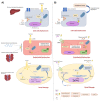Xenobiotics Delivered by Electronic Nicotine Delivery Systems: Potential Cellular and Molecular Mechanisms on the Pathogenesis of Chronic Kidney Disease
- PMID: 36142207
- PMCID: PMC9498982
- DOI: 10.3390/ijms231810293
Xenobiotics Delivered by Electronic Nicotine Delivery Systems: Potential Cellular and Molecular Mechanisms on the Pathogenesis of Chronic Kidney Disease
Abstract
Chronic kidney disease (CKD) is characterized as sustained damage to the renal parenchyma, leading to impaired renal functions and gradually progressing to end-stage renal disease (ESRD). Diabetes mellitus (DM) and arterial hypertension (AH) are underlying diseases of CKD. Genetic background, lifestyle, and xenobiotic exposures can favor CKD onset and trigger its underlying diseases. Cigarette smoking (CS) is a known modified risk factor for CKD. Compounds from tobacco combustion act through multi-mediated mechanisms that impair renal function. Electronic nicotine delivery systems (ENDS) consumption, such as e-cigarettes and heated tobacco devices, is growing worldwide. ENDS release mainly nicotine, humectants, and flavorings, which generate several byproducts when heated, including volatile organic compounds and ultrafine particles. The toxicity assessment of these products is emerging in human and experimental studies, but data are yet incipient to achieve truthful conclusions about their safety. To build up the knowledge about the effect of currently employed ENDS on the pathogenesis of CKD, cellular and molecular mechanisms of ENDS xenobiotic on DM, AH, and kidney functions were reviewed. Unraveling the toxic mechanisms of action and endpoints of ENDS exposures will contribute to the risk assessment and implementation of proper health and regulatory interventions.
Keywords: ENDS; cigarette smoking; diabetes mellitus; flavoring agents; hypertension; nicotine; risk assessment; volatiles organic compounds.
Conflict of interest statement
The authors declare that the research was conducted in the absence of any commercial or financial relationships that could be construed as a potential conflict of interest.
Figures

Similar articles
-
Comparison of biomarkers of exposure among US adult smokers, users of electronic nicotine delivery systems, dual users and nonusers, 2018-2019.Sci Rep. 2023 May 5;13(1):7297. doi: 10.1038/s41598-023-34427-x. Sci Rep. 2023. PMID: 37147399 Free PMC article.
-
Clinical Pharmacology of Electronic Nicotine Delivery Systems (ENDS): Implications for Benefits and Risks in the Promotion of the Combusted Tobacco Endgame.J Clin Pharmacol. 2021 Aug;61 Suppl 2(Suppl 2):S18-S36. doi: 10.1002/jcph.1915. J Clin Pharmacol. 2021. PMID: 34396553 Free PMC article.
-
Effects of reduced-risk nicotine-delivery products on smoking prevalence and cigarette sales: an observational study.Public Health Res (Southampt). 2023 Sep;11(7):1-39. doi: 10.3310/RPDN7327. Public Health Res (Southampt). 2023. PMID: 37795840
-
Mechanisms of toxicity and biomarkers of flavoring and flavor enhancing chemicals in emerging tobacco and non-tobacco products.Toxicol Lett. 2018 May 15;288:143-155. doi: 10.1016/j.toxlet.2018.02.025. Epub 2018 Feb 23. Toxicol Lett. 2018. PMID: 29481849 Free PMC article. Review.
-
The risk profile of electronic nicotine delivery systems, compared to traditional cigarettes, on oral disease: a review.Front Public Health. 2023 May 15;11:1146949. doi: 10.3389/fpubh.2023.1146949. eCollection 2023. Front Public Health. 2023. PMID: 37255760 Free PMC article. Review.
Cited by
-
Smoking as a causative factor in chronic kidney disease: a two-sample Mendelian randomization study.Ren Fail. 2025 Dec;47(1):2453014. doi: 10.1080/0886022X.2025.2453014. Epub 2025 Jan 21. Ren Fail. 2025. PMID: 39837594 Free PMC article.
-
Circulating extracellular microvesicles associated with electronic cigarette use increase endothelial cell inflammation and reduce nitric oxide production.Exp Physiol. 2024 Sep;109(9):1593-1603. doi: 10.1113/EP091715. Epub 2024 Aug 2. Exp Physiol. 2024. PMID: 39092897 Free PMC article.
-
A review of vaping's health effects, treatment, and policy implications: Nursing's call to action.Nurse Pract. 2024 Sep 1;49(9):36-47. doi: 10.1097/01.NPR.0000000000000221. Epub 2024 Aug 27. Nurse Pract. 2024. PMID: 39186124 Free PMC article. Review.
-
Dexpanthenol protects against nicotine-induced kidney injury by reducing oxidative stress and apoptosis through activation of the AKT/Nrf2/HO-1 pathway.Naunyn Schmiedebergs Arch Pharmacol. 2024 Feb;397(2):1105-1114. doi: 10.1007/s00210-023-02671-7. Epub 2023 Aug 22. Naunyn Schmiedebergs Arch Pharmacol. 2024. PMID: 37606756
References
-
- Reitsma M.B., Fullman N., Ng M., Salama J.S., Abajobir A., Abate K.H., Abbafati C., Abera S.F., Abraham B., Abyu G.Y., et al. Smoking prevalence and attributable disease burden in 195 countries and territories, 1990–2015: A systematic analysis from the global burden of disease study 2015. Lancet. 2017;389:1885–1906. doi: 10.1016/S0140-6736(17)30819-X. - DOI - PMC - PubMed
Publication types
MeSH terms
Substances
Grants and funding
LinkOut - more resources
Full Text Sources
Medical

